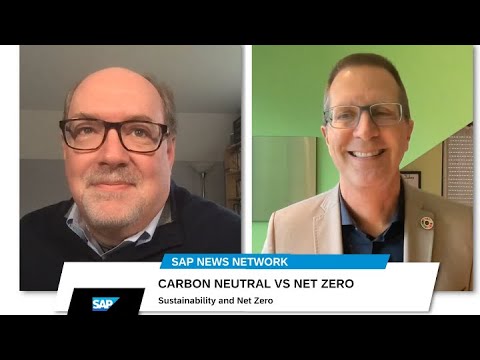The science is clear that human activity, primarily burning fossil fuels and massive deforestation, has accelerated climate change. Companies need to set science-based net-zero targets to limit global temperature rise to 1.5°C in alignment with the Paris Agreement. Achieving net-zero emissions worldwide requires fundamental changes to many of our social and economic systems.
Up until now, nearly 1,800 companies, including SAP, have committed to becoming net zero across their value chains. These commitments aim to achieve an emissions state consistent with societal climate and sustainability goals and within the biophysical boundaries of the planet. At the beginning of 2022, SAP committed to achieve net-zero emissions by 2030. The United Nations’ Intergovernmental Panel on Climate Change (IPCC) defines net zero as that point when “anthropogenic emissions of greenhouse gases to the atmosphere are balanced by anthropogenic removals over a specified period.” The Paris Agreement sets out the need to achieve this balance by 2050.

A company’s net-zero emissions target is a climate action target in which a company aims to reduce its emissions to zero, on a net basis. The term “net” comes from the view that most companies will not be able to operate without emitting at least some greenhouse gases, so they will need to remove their unavoidable residual emissions from the atmosphere to get to net zero.
Getting to net zero is not easy or straightforward. Questions remain on how companies develop their net-zero emissions targets and ensure their decarbonization strategies track to ambitious pathways. Challenges exist, such as inconsistently defined net-zero targets, what emission sources and activities should be included, timelines to achieve the goals, and how companies plan to achieve their target.
The Science Based Targets initiative (SBTi) is one of the leading global initiatives that helps companies set ambitious emission reduction targets and credible decarbonization strategies. The SBTi’s Corporate Net-Zero Standard is the world’s first framework for corporate net-zero target setting in line with climate science. It includes the guidance, criteria, and recommendations companies need to set science-based net-zero targets consistent with limiting global temperature rise to 1.5°C above pre-industrial levels.
The scope of science-based targets for net zero is broad, encompassing all relevant greenhouse gas emissions across a company’s value chain, including direct emissions from operations (Scope 1), emissions from purchased energy (Scope 2), and indirect emissions from upstream and downstream sources such as business travel, employee commuting, purchased goods and services, or products in use (Scope 3).
This SBTi framework includes a set of criteria that companies must meet to ensure that their targets are scientifically robust and credible. These criteria include:
- Complete an emission inventory following the GHG Protocol.
- Set near- and long-term science-based targets to reduce value chain emissions.
- Implement a strategy to achieve science-based targets.
- Disclose target progress annually.
To claim to have reached net zero, companies must neutralize the impact of emissions that remain unabated in the long-term net-zero target year. Examples of such counterbalancing activities include purchasing carbon credits that support programs that prevent deforestation or support reforestation or investing in carbon-dioxide removal (CDR) technologies such as direct air capture (DAC) with permanent geological carbon storage. The SBTi allows a maximum of 10% removals for a long-term net-zero target and does not allow the traditional use of offsets anymore, except to achieve short-term targets as an interim transition step. Consequently, the Net-Zero Standards expects companies to radically reduce emissions by 90% by no later than 2050.
To set a science-based target for net-zero, a company must first conduct a detailed assessment of its greenhouse gas emissions in alignment with the Greenhouse Gas Protocol, including identifying emissions sources and determining the extent of its emissions across its value chain. Based on this assessment, the company can set an ambitious, measurable emissions reduction target consistent with the Paris Agreement’s goals and aligned with the best available science. Beyond the assessment, companies then need to set ambitious targets and actionable strategies, both near- and long-term to reduce value chain emissions.
“We are currently assessing our net-zero reduction pathway and corresponding reduction strategies across a number of areas of the SAP business to meet the demanding requirements of the SBTi,” said Lilli-Jane Popp, sustainability specialist at SAP. “We want to continually use the highest standards and use the latest science in setting targets and developing our plans to achieve net zero by 2030.”
Scope 3 emissions are challenging to reduce yet they are where most emissions occur in a company’s value chain. They are the indirect greenhouse gas emissions that occur outside of operations, like emissions produced by suppliers and customers when using the company’s products. These emissions are considered difficult to account for because they depend on a complex network of suppliers, customers, and other stakeholders. Accounting for Scope 3 emissions requires a deep understanding of a company’s value chain, a commitment to collecting and analyzing data, and collaboration with suppliers and other stakeholders.
Delivering and disclosing progress on their decarbonization targets helps companies reduce their environmental impact, improve their reputation and brand value, and attract environmentally conscious consumers and investors. Also, by setting science-based targets, companies can ensure that they are prepared for the transition to a low-carbon economy and avoid the risks associated with climate change, such as regulatory changes, reputational damage, and physical impacts.
However, achieving net-zero targets to limit global warming to 1.5°C will require significant effort and investments from companies and strong collaboration across sectors. But it is essential for ensuring a sustainable and livable future. According to the latest IPCC report, we have already reached 1.1°C of warming above pre-industrial levels. We are living in a decisive decade for climate action with our planet warming at an unprecedented pace. Companies must align with the most ambitious, credible, and robust frameworks, like the SBTi, to reach global net zero by 2050 at the latest.
Michael McComb is global head of Sustainability Communications at SAP.



